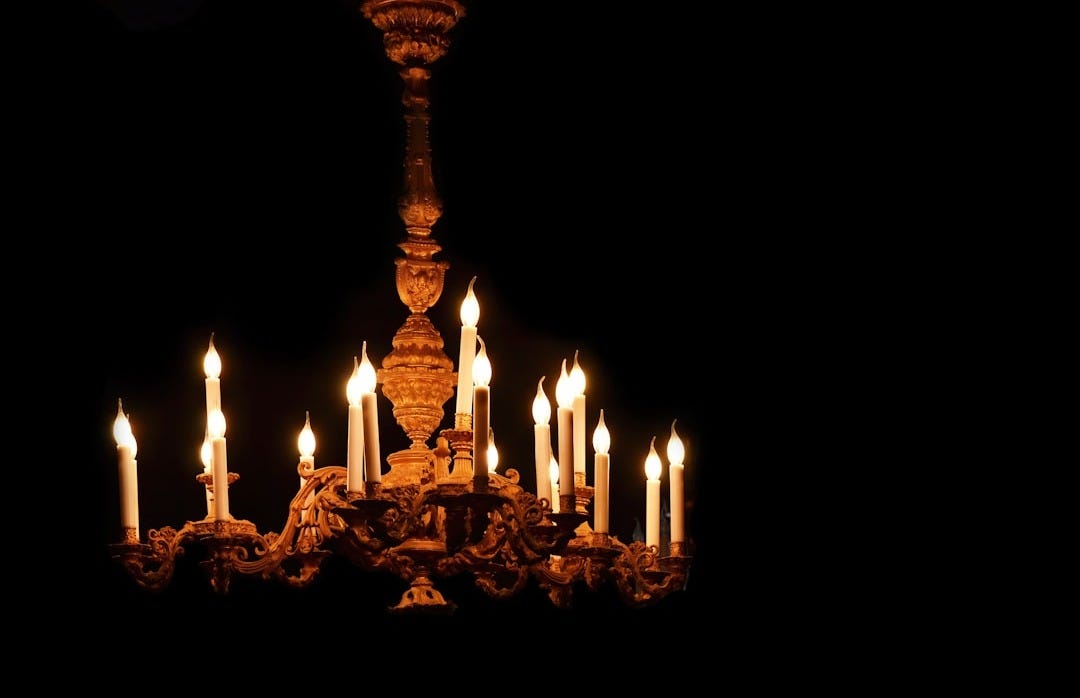A Brief and Bright History of the Chandelier
Enlightenment comes in many ways; sometimes it needs to be hung up right over your head.

It hasn’t been that long since Delhi’s ex-CM Kejriwal’s image of humble grandeur was reflected back by his ironically named Sheesh Mahal, but I guess Delhi’s current reigning powers wanted to give the public a refresher on their priorities.
So, as things stand, the now-CM Rekha Gupta took it upon herself to help the common man in conditions that accurately reflect their state: a ₹60 Lakh renovation of her bungalow with all the necessities; twenty-four ACs, five TVs, and three chandeliers. There’s a reason it’s been called Janata ka Sheesh Mahal (The People’s Mirror Palace).
Now, let’s be considerate, shall we? How can we expect a servant of the people to work in the tragic heat of Delhi’s increasing temperature and pollution woes? And why should she be robbed of entertainment? But of particular interest, and the subject of this little digression, is the meek chandelier with a grand but tragic history, rooted in (somewhere) colonialism.
The Bright (White) Etymology
This is a very interesting walk down the history of a word that began with the Latin word candere (to shine or to be white—psst!), from which arose candela (something that shined, either a torch, a light, or a candle). This was adopted by Old English, and the device in which the candle was held (then spelt candel) was called a candeltreow (candle tree). Latin, however, used candelabrum, which became chandelabre in Old French by the 10th century, later evolving into chandelier. It was this form that was later adopted into English to represent the ceiling-mounted lighting solution that we all know (and some like Delhi’s CMs love).
History Through Grand Halls
The chandelier that we all see as a prominent backdrop in set-pieces of European history—bathing its many palaces, ballrooms, and celebratory confinements in a warm glow—began, just like its root word, as a candle. A tool of the commonfolk, rendered in animal fat, stinky, and sooty. Yeah, that checks out.
When it all began, a stinky candle would do for people who only needed minimal lighting to scratch a midnight itch, as most ended their days with the diminishing sunlight. But when hovels became grander homes, a better solution was needed. The answer was to raise a few candles (rendered in beeswax, if the person was richer) and hang them on the ceiling through various contraptions. Soon, this form of the candle cluster became associated with the Sun, and why wouldn’t it? The European nobility loved to liken themselves to descendants of a higher power. And what higher power than the Sun itself?
So, as it goes, this “solar-powered” nobility started upping the scale of grandeur with their chandeliers. King Louis XIV is said to have used 20,000 candles to whiten up the Hall of Mirrors in Versailles. And this iconography struck hard in the minds of the ruling class. When they washed ashore the kingdoms of this sub-continent, the chandelier was always in tow to whitewash their homes brighter than those of the native candle-lit dwellings. It so happens that nobility is nobility, interestingly. Therefore, it should come as no surprise that even those kings, queens, and nobles who called Indian kingdoms their homes, or were in servitude to their colonial overlords, the idea of brightening up their castles, forts, and kothis (villas) with chandeliers was right up their alley.
This went on for quite a while, as we all know, and although we have washed away the stain of colonial Raj from our collars and cuffs, you can find remnants of this sunlight mimicry in opulent masterpieces of glass and metalwork hanging in Nawabi palaces and other like-minded middlemen nobility of that era.
Rule of the Bright
The poor candle, of course, never asked to be anything more than a simple tool to expel darkness. It’s just that its evolutionary cousins in chandeliers were more efficient at this task. They could repel the darkness of the physical kind as well as that of the class. After all, a pocket with only a few polished coins jangling about is mostly empty. And what is emptiness but a welcome mat for darkness?
Chandeliers, therefore, found homes in a class that has become dominant in the world. It shouldn’t surprise you that, if you were to walk into the homes of politicians, celebrities, or uber-rich businessmen, these chandeliers proudly present themselves as the rightful heirs of the very people who now work towards the upliftment of the common folk. These homes are not palaces but workstations of the divine. They wash away the sins of the puny, of those dwelling in darkness of poverty (even the middle class, for we are poor than then in a relative sense, aren’t we?), and of those so bygone in their darkness that they can’t light a spark by rubbing two steel-alloy, government-minted coins together.
It’s only in the brightness generated by the godly chandeliers under which the elite of the world find enlightenment that enact policies to benefit the people. Abraham Lincoln was wrong with his “of the people, by the people, for the people.” Only one look and you’ll find that these socialistic dealings don’t help us at all, whether enacted to curb pollution, eliminate poverty, or improve living standards.
No, he and all of us got it absolutely wrong. It should have been “from the chandelier, by the chandelier, for the chandelier,” for only a million-or-so candles can bring light in the darkest of times. Us poor mortals might only get a few chandeliers in our lives, and one of them already went with Sia’s 2014 chart topper.
Perhaps Arvind Kejriwal and Rekha Gupta understand this ideology better than we do. Why else, do you think, do they want PWD to renovate their residences with chandeliers? It’s enlightenment wrapped in peak Janata seva!
References
· https://www.saturdayeveningpost.com/2022/11/in-a-word-shedding-some-light-on-candle-holders/
· https://www.abc.net.au/news/2018-12-29/chandelier-symbol-of-wealth-and-power/10442720



